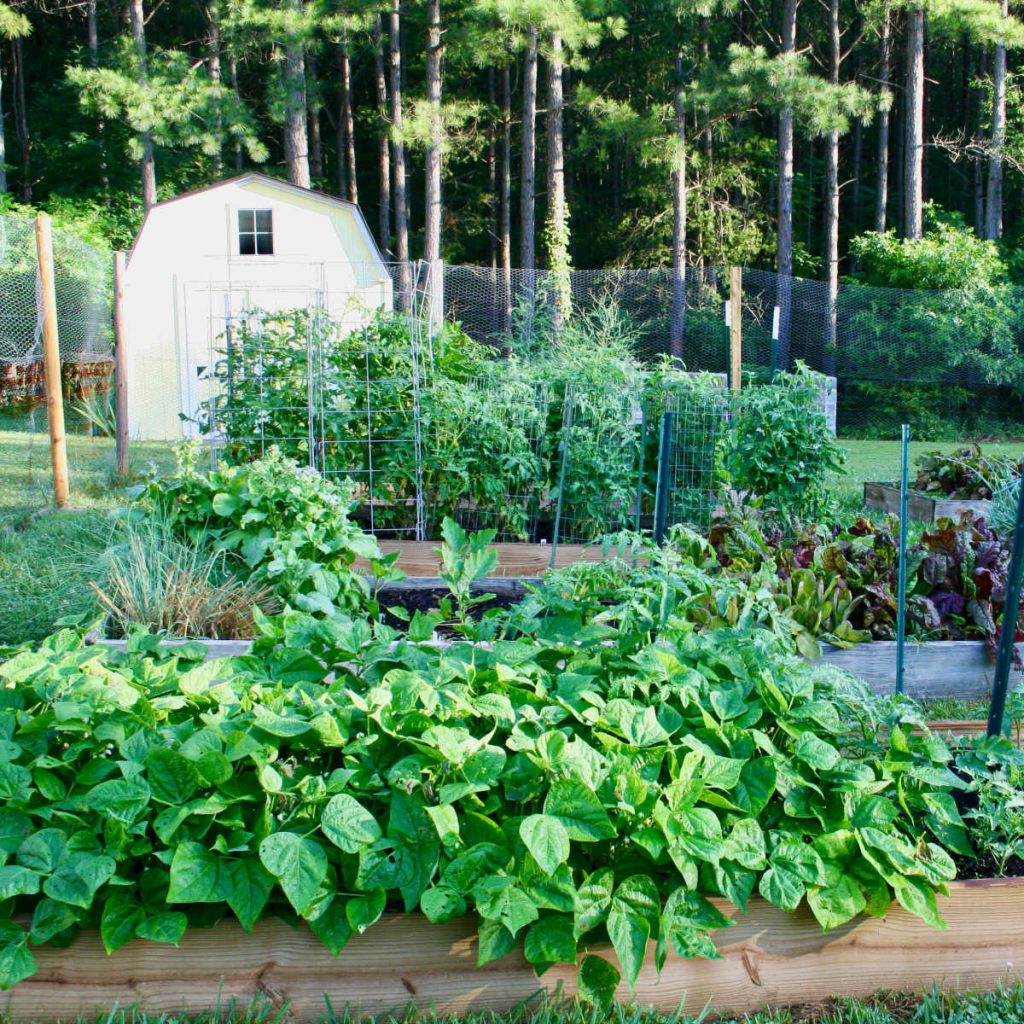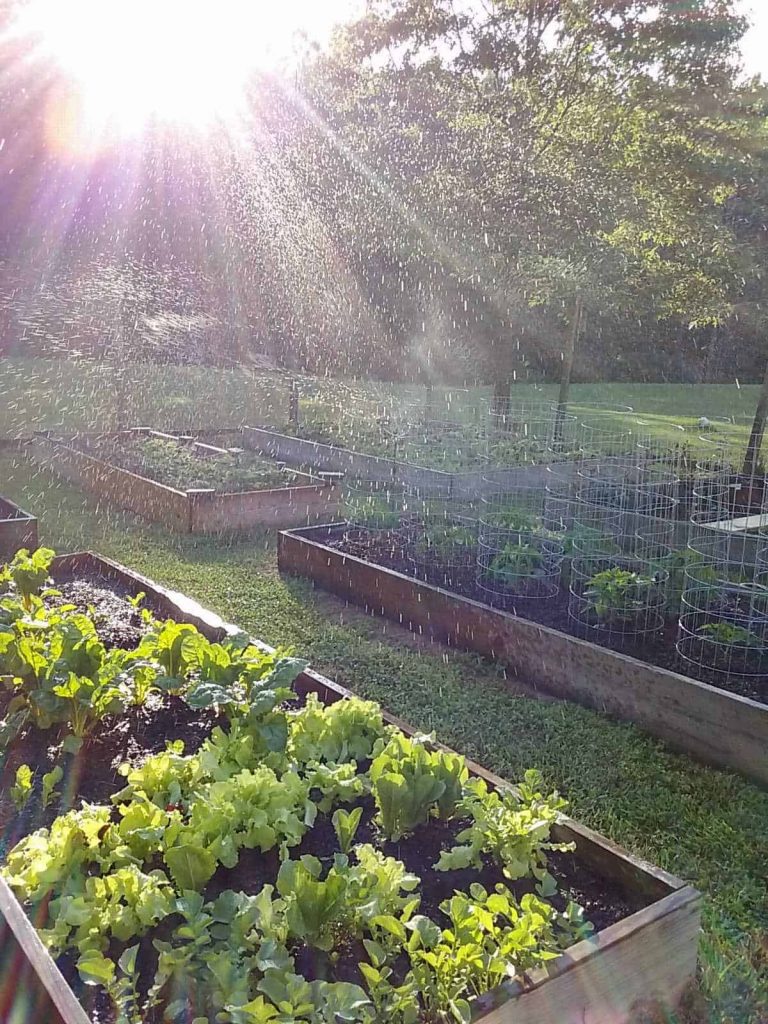What are the vegetable garden tips and tricks that the top gardeners and homesteaders know (and you don’t?). I’ve been a gardener for over 30 years and a master gardener for 10 years. Here are my top tips and tricks to help you grow great vegetables. Plus, I’ll share with you the top 5 vegetable gardening mistakes that I saw during my years working at a garden center, and how to fix them.
If you’re new to vegetable gardening, you may also want to read the following articles to help you learn gardening basics:
Composting Basics – Learn how to start a compost pile. Compost enriches the soil and provides nutrients to vegetable plants.
Seed Starting – Some vegetables can be started directly in garden soil from seeds. These includes beans, peas, lettuce, carrots, beets, and similar root crops. Other vegetables should be started in smaller containers and moved to the garden or purchased as plants, such as tomatoes. Learn all about seed starting in my handy guide.
Your Guide to Soil – Learn all about garden soil. What is soil? Why is it so important to growing a good garden?

How to Start a Vegetable Garden from Scratch: Tips and Tricks
So you want to start a vegetable garden? Congratulations!
Growing your own vegetables is both fun and rewarding. It’s a great activity to enjoy with children. You’ll have plenty of fresh vegetables to enjoy with your meals and you can grow whatever you like.
The following 10 vegetable garden tips and tricks will help you get your garden off to a great start.
- Choose the sunniest location in your yard for your vegetable garden. Out of all the requirements to grow great vegetables, sunlight is one of the most important. Although some vegetables grow fine in partial sun, the more sunlight your vegetables receive, the better.
- Get a soil test before planting. I can’t tell you how important this is! Most vegetables require a soil pH around 6 – 6.5 and rich, loamy soil for growth. (If you don’t understand that sentence, don’t worry – read the guide to soil, above). The only way to determine soil pH is to get it tested. Soil tests cost around $10 – $15 and come with detailed instructions on what to add to the soil to make it suitable for growing vegetables. Learn more about soil testing and find your local Cooperative Extension office online for the nearest soil testing location.
- Make sure your vegetables get plenty of water. Water your plants daily or install a sprinkler system to ensure they get plenty of water. One inch per week of rain is the usual recommendation. I use a rain gauge in the garden, and also water my hot sunny southern garden twice a day during the summertime using a sprinkler system.
- Wait to plant tender vegetables (peppers, eggplant, tomatoes) until after the frost date for your region. The last average frost date for your region may be found on the USDA Hardiness map. The United States is divided into gardening zones or regions based on when the last average frost date is in the spring and the first average frost date in the fall. You can plant tender vegetables starting after the last average frost date.
- Pick vegetables frequently to encourage production. Vegetables like tomatoes are the reproductive (seed bearing) part of the plant. Picking vegetables with seeds in them – peppers, eggplant, tomatoes, peas, green beans – encourages the plant to produce more flowers and more edible vegetables. When you pick such vegetables, the plant gets the signal it has ‘lost’ the seed producing part, and because it wants to reproduce, it makes more. Pick more = plant makes more.
- Add compost – lots of compost! Compost is made from decomposing plant materials such as grass clippings, leaves, and vegetable and fruit scraps. As the material decomposes, it returns elements including nitrogen, carbon, potassium, and many micronutrients to the soil, along with bacteria, fungi, and other microorganisms that enrich the soil. You can’t add too much compost. Start your own pile. It’s free “plant food”!
- Catch and prevent insect damage early. Insects can quickly turn a backyard vegetable garden into a mess. Be vigilant. Look at your plants daily or at least every few days and notice any damage to the leaves or other parts. Holes in the leaves, brown leaves, gray leaves, or small bugs swarming your plants are immediate warning signals. Learn the signs of insect damage and how to prevent or treat it.
- Vegetable gardens aren’t supermarkets. You’ll end up with a lot of one type of vegetable (zucchini, anyone?) and one type may fail (I have yet to have good luck with eggplant, and last year, my peppers were smothered by the cucumbers.) Many gardeners learn home canning techniques and other methods to preserve the harvest. Another option is to give away extra vegetables to family, friends, neighbors, or the local food pantry. My church accepts fresh vegetable donations into the food pantry to distribute to the community, and many others, including non-religious food banks also accept donations.
- Clean up the garden at the end of the season. After the first frost, most of your summer vegetables turn brown and die. Pull them up and put them in the trash. Do not leave them in the garden all winter long. This may encourage several plant diseases to take up residence, too.
- Plant what you like, and don’t worry. Don’t worry about growing economical vegetables, fancy vegetables, or anything except growing what you love. You’re not Scarlett O’Hara trying to scratch out enough food to feed your family from the ruins of Tara. Gardening should be fun. If it’s not, it’s time to reassess what you’re growing!

5 Vegetable Garden Mistakes – and How to Fix Them
Growing your own vegetables is a great way to ensure an adequate supply of nutritional fresh vegetables. The easiest ones to grow are often the spring vegetables including lettuce, radishes, and spinach, so now is definitely a great time to start a few pots, containers, or a raised bed.
Problem 1: Planting seeds too close together – and not thinning the seedlings
It’s easy to dump too many seeds in a row. Many vegetable seeds are tiny, and as you shake the envelope out, more than one lands in a planting hole, resulting in a crowd of seedlings. It’s tempting to leave them alone; after all, five plants are better than one, right? Unfortunately, the roots tangle together, the plants crowd each other out, and you’ll end up with spindly, unhealthy plants.
Solution: Thinning. Thinning refers to the process of removing the smaller, weaker seedlings. If you can transplant them, fine, but if not, compost them. It feels like a waste of good plants but if you don’t think out the row, you really will end up with a poor yield.
Problem 2: Allowing seeds and plants to dry out
You can’t rely on nature to provide seedlings with all the water they need. I water outdoor seedlings and seed starting trays twice daily, once in the morning, and once at night, giving them a good soaking. Make sure that any pots and containers have drainage holes to allow excess water to drip out or you will drown your plants.
Solution: Twice daily watering. If you are lucky enough to have sprinklers to water your vegetable garden, a timer is a great help, especially if you’re forgetful. The timer automatically starts and stops the sprinklers.
Problem 3: Overplanting
It’s easy to go crazy planting vegetables if this is your first garden. Unlike the grocery store, however, where you can pick up just one head of lettuce for the week, you’ll find that your garden offers its bounty of vegetables all at once! A rush of radishes, a flood of lettuce, and suddenly you’re wondering if you can sneak the extras onto your neighbor’s porch.
Solution: Estimate how much your family will need and plant only as much as you need. Here is a good article from The Spruce that includes how many plants to estimate per person.
Problem 4: Not enough light
Vegetable plants require full sunlight, with some, such as green beans and lettuce, able to grow well in partial sunlight. Many people don’t understand what full sunlight means and assume that dappled shade from a tree is fine, for example, or bright afternoon sunlight is enough. It may not be. If your garden is struggling, and there’s deep shade cast on it from a shed, fence, or tree, you may need to reconsider where you’ve planted your vegetables.
Solution: Move the garden beds next year to a sunnier spot. If that’s impossible, try growing container vegetables and move the containers into the sunlight. Most people have at least one spot in their yard that gets sunlight. It might not be ideal for an in-ground or raised vegetable garden bed but it may be able to accommodate a few large containers.
Problem 5: Setting tender plants out too early
It’s tempting to plant everything now – cucumbers, tomatoes, peppers, eggplant, melons. But these are tender (frost-sensitive) plants that cannot take freezing temperatures. Here in the Piedmont region of Virginia, the last frost date varies considerably. We’ve had a mild spring. I ask myself, “Should I take a chance and plant my cantaloupe seeds? The tomatoes?” But you never know when a sudden cold snap will arrive.
Solution: Find out the frost-free date for your gardening zone. Wait to plant heat-loving vegetables until after the average date of the last frost. If a frost threatens, bring potted or container plants inside, and cover outdoor garden beds with blankets, sheets, cardboard or newspaper (just overnight – take it off in the morning.)
Vegetable Gardening Keeps Me Grounded
Gardening has been my emotional outlet for many years but it’s never been as important as it is now. Weeding the flower beds, starting my vegetable garden, tending the raised vegetable beds…it helps me feel grounded, secure.
Even though I’ve been growing vegetables for over 30 years, I still make plenty of mistakes. These are the most common vegetable garden mistakes I’ve encountered when giving talks and lectures to garden clubs and the general public. They also reflect many of the frequently asked questions I see here at Home Garden Joy and on our Facebook page. (Not a member? Check us out today!).
Don’t be afraid to ask questions or leave comments on the Home Garden Joy Facebook page. Everyone has to start somewhere!
More Gardening Tips
This post was written in 2016 and updated April 2021 with new information, improved links, and better images.




